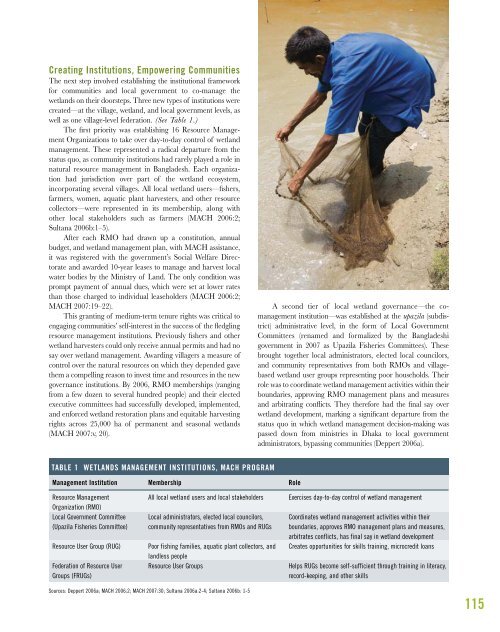Growing the Wealth of the Poor - World Resources Institute
Growing the Wealth of the Poor - World Resources Institute
Growing the Wealth of the Poor - World Resources Institute
You also want an ePaper? Increase the reach of your titles
YUMPU automatically turns print PDFs into web optimized ePapers that Google loves.
Creating Institutions, Empowering CommunitiesThe next step involved establishing <strong>the</strong> institutional frameworkfor communities and local government to co-manage <strong>the</strong>wetlands on <strong>the</strong>ir doorsteps. Three new types <strong>of</strong> institutions werecreated—at <strong>the</strong> village, wetland, and local government levels, aswell as one village-level federation. (See Table 1.)The first priority was establishing 16 Resource ManagementOrganizations to take over day-to-day control <strong>of</strong> wetlandmanagement. These represented a radical departure from <strong>the</strong>status quo, as community institutions had rarely played a role innatural resource management in Bangladesh. Each organizationhad jurisdiction over part <strong>of</strong> <strong>the</strong> wetland ecosystem,incorporating several villages. All local wetland users—fishers,farmers, women, aquatic plant harvesters, and o<strong>the</strong>r resourcecollectors—were represented in its membership, along witho<strong>the</strong>r local stakeholders such as farmers (MACH 2006:2;Sultana 2006b:1–5).After each RMO had drawn up a constitution, annualbudget, and wetland management plan, with MACH assistance,it was registered with <strong>the</strong> government’s Social Welfare Directorateand awarded 10-year leases to manage and harvest localwater bodies by <strong>the</strong> Ministry <strong>of</strong> Land. The only condition wasprompt payment <strong>of</strong> annual dues, which were set at lower ratesthan those charged to individual leaseholders (MACH 2006:2;MACH 2007:19–22).This granting <strong>of</strong> medium-term tenure rights was critical toengaging communities’ self-interest in <strong>the</strong> success <strong>of</strong> <strong>the</strong> fledglingresource management institutions. Previously fishers and o<strong>the</strong>rwetland harvesters could only receive annual permits and had nosay over wetland management. Awarding villagers a measure <strong>of</strong>control over <strong>the</strong> natural resources on which <strong>the</strong>y depended gave<strong>the</strong>m a compelling reason to invest time and resources in <strong>the</strong> newgovernance institutions. By 2006, RMO memberships (rangingfrom a few dozen to several hundred people) and <strong>the</strong>ir electedexecutive committees had successfully developed, implemented,and enforced wetland restoration plans and equitable harvestingrights across 25,000 ha <strong>of</strong> permanent and seasonal wetlands(MACH 2007:v, 20).A second tier <strong>of</strong> local wetland governance—<strong>the</strong> comanagementinstitution—was established at <strong>the</strong> upazila (subdistrict)administrative level, in <strong>the</strong> form <strong>of</strong> Local GovernmentCommittees (renamed and formalized by <strong>the</strong> Bangladeshigovernment in 2007 as Upazila Fisheries Committees). Thesebrought toge<strong>the</strong>r local administrators, elected local councilors,and community representatives from both RMOs and villagebasedwetland user groups representing poor households. Theirrole was to coordinate wetland management activities within <strong>the</strong>irboundaries, approving RMO management plans and measuresand arbitrating conflicts. They <strong>the</strong>refore had <strong>the</strong> final say overwetland development, marking a significant departure from <strong>the</strong>status quo in which wetland management decision-making waspassed down from ministries in Dhaka to local governmentadministrators, bypassing communities (Deppert 2006a).TABLE 1WETLANDS MANAGEMENT INSTITUTIONS, MACH PROGRAMManagement InstitutionResource ManagementOrganization (RMO)Local Government Committee(Upazila Fisheries Committee)Resource User Group (RUG)Federation <strong>of</strong> Resource UserGroups (FRUGs)MembershipAll local wetland users and local stakeholdersLocal administrators, elected local councilors,community representatives from RMOs and RUGs<strong>Poor</strong> fishing families, aquatic plant collectors, andlandless peopleResource User GroupsRoleExercises day-to-day control <strong>of</strong> wetland managementCoordinates wetland management activities within <strong>the</strong>irboundaries, approves RMO management plans and measures,arbitrates conflicts, has final say in wetland developmentCreates opportunities for skills training, microcredit loansHelps RUGs become self-sufficient through training in literacy,record-keeping, and o<strong>the</strong>r skillsSources: Deppert 2006a; MACH 2006:2; MACH 2007:30; Sultana 2006a:2-4; Sultana 2006b: 1-5115
















